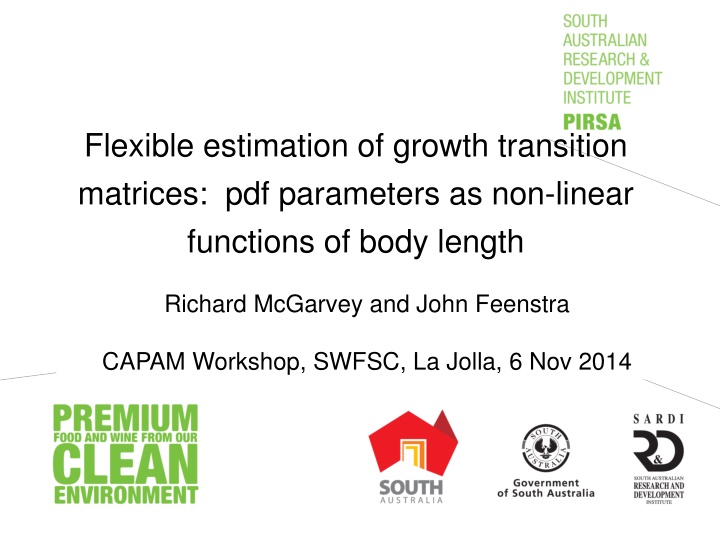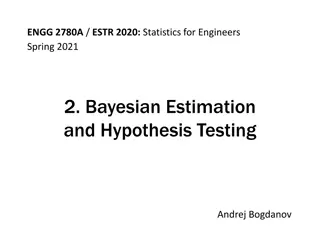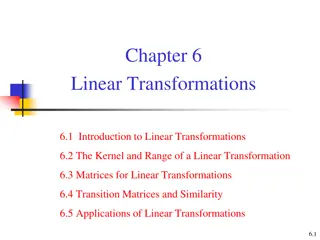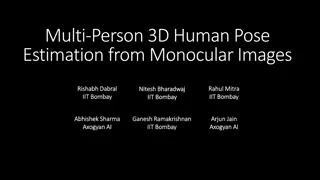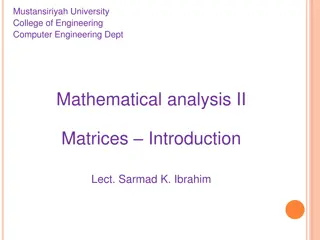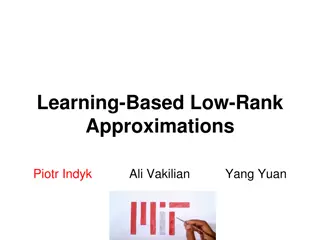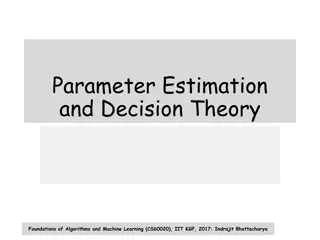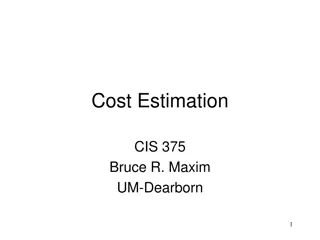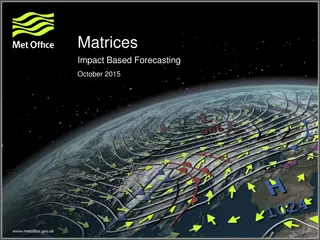Flexibility in Growth Transition Matrices Estimation
Growth transition matrices play a crucial role in length-based assessment models of fisheries, especially in species like the South Australian lobster. This research delves into the intricate process of estimating transition probabilities based on body length, shedding light on factors affecting growth rates in lobsters. The study explores how mortality rates are derived from combined length frequencies and growth data, utilizing a matrix of transition probabilities in discrete time and length bins. Factors such as depth and population density are investigated as significant determinants of growth patterns in lobsters, showcasing the complexity of modeling growth transitions in marine populations.
Download Presentation

Please find below an Image/Link to download the presentation.
The content on the website is provided AS IS for your information and personal use only. It may not be sold, licensed, or shared on other websites without obtaining consent from the author.If you encounter any issues during the download, it is possible that the publisher has removed the file from their server.
You are allowed to download the files provided on this website for personal or commercial use, subject to the condition that they are used lawfully. All files are the property of their respective owners.
The content on the website is provided AS IS for your information and personal use only. It may not be sold, licensed, or shared on other websites without obtaining consent from the author.
E N D
Presentation Transcript
Flexible estimation of growth transition matrices: pdf parameters as non-linear functions of body length Richard McGarvey and John Feenstra CAPAM Workshop, SWFSC, La Jolla, 6 Nov 2014
Background: Growth transition matrices Length-based assessment models are sensitive to the estimated model growth. When age proportions are available, mortality rate can be estimated directly. But with length samples, growth must be combined with length frequencies to estimate mortality. Because length-based assessments operate in discrete time and with discrete length bins, growth is described by a matrix of transition probabilities.
Growth in South Australian lobster Southern rock lobster in southeastern Australia is the largest fishery by GVP. Growth in South Australian lobster occurs twice yearly: summer and winter moulting seasons. Males and females grow differently. After maturity, female growth slows. Andre Punt s length-based lobster stock assessment model is used in Tasmania, Victoria, and South Australia. Length transition matrices in South Australia were estimated using a relatively large data set of ordinary fishery single tag recoveries.
Data input for estimating growth transition matrices Matrix transition probabilities are estimated from these ordinary fishery single tag-recovery data. Often, but not always, the tag-recoveries are binned. For lobsters tagged and released in each pre-growth length bin, the fitted data are the proportions of recaptured lobsters that remain in that pre-growth bin, or that grow into larger length bins, across each assumed discrete time of growth transition. For crustaceans, these times of growth transition are the seasonal moulting times.
Factors affecting growth rate in South Australian lobster: Depth Lobster growth rates were found, using Francis GROTAG (McGarvey, Ferguson, Prescott, Mar Freshwater Res, 1999) to vary with several factors. Here, mean yearly growth rate for male and female lobsters of 100 mm CL is shown to decrease with depth:
Factors affecting growth rate in South Australian lobster: Population density (as number CPUE by statistical reporting block) Lobster growth also decreased with population density. Here males are shown:
Female growth deviates from Von Bertalanffy Female growth differs from the strict linear decrease with body length postulated by a Von Bertalanffy model of mean growth rate. When we first developed this method (McGarvey and Feenstra 2001, Mar Freshwater Res), female growth deccelerated after reaching maturity. This is common for female crustacean species. We sought to a more flexible growth rate description that von Bertalanffy permits. Specifically, we sought to improve the accuracy of estimates of mean growth increment, and variance of growth increment, as functions of body length, in a length-transition framework.
Length-transition probabilities computed by integration over a selected pdf Usually the individual elements are not estimated as individual parameters. Rather a model dependence on pre-growth length is formulated. In many length-transition estimators, the elements of the matrix, notably the proportions (i.e., probabilities) growing from each starting (pre-growth) length bin to length bins of greater body length are computed by integrating under a pdf over pre-chosen integration limits. The integration limits under the pdf (here, for males, ), do not equal the actual lobster length bin separation boundaries. ( ( ( ( ( ( ( ) ,1 , 1,2 , 2,3 , 3,4 , 4,5 , 5,6 , 6, +
Computing elements of the growth transition matrix as areas under the pdf curve Example normal pdf: fast growing males The values of proportions growing (or not) in each matrix column are the probabilities under the estimated pdf. 0.4 0.35 Proportion growing three length bins 0.3 Proportion growing two length bins 0.25 0.2 Proportion growing to the next length bin 0.15 0.1 Proportion of lobsters remaining in same length bin 0.05 0 -2 -1 0 1 2 3 4 5 6 7 Pdf integration domain
Tested gamma and normal pdfs We have tried normal and gamma pdfs. Results presented below used a normal pdf, and length bins that are 4 mm carapace length (CL) wide. In the paper where we first described this approach (McGarvey and Feenstra 2001, Mar Freshwater Res), we presented results for 8 mm bins and a gamma.
Polynomial functions of body length define the two parameters of each normal pdf The normal pdf parameters are estimated as polynomial functions of body length: ( ) 0 1 l l = + + ( ) 0 1 l l = + + + + 2 3 l l l l 2 3 2 3 2 3 We tested up to cubic for both mean and sd normal pdf parameters: The gamma pdf parameters were also written as polynomials of body length. A von Bertalanffy model is given by linear dependence on body length: ( ) 0 1 l l = +
Computing pdf parameters as functions of pre- growth body (carapace) length Example normal pdf: fast growing males Pdf parameters ( ) defined as functions of the pre-growth lobster carapace length ( = 84.5 mm CL) 0.4 0.35 0.3 Mean of pdf = 0.25 0.2 0.15 SD of pdf = 0.1 or 0.05 0 -2 -1 0 1 Pdf integration domain 2 3 4 5 6 7
Simple non-linear functions are used to relate body length bin mid-point to the pdf shape and location: In Summary Each element of the column vector of growth proportions in the growth matrix is computed by integration under a pdf. Each pdf is defined by two pdf parameters ( ). Each pdf parameter is estimated as a continuous polynomial (or power) function of pre-growth body length, specifically the length bin midpoint. Using non-linear functions of body length, such as polynomial or power functions, increases growth model flexibility. A von Bertalanffy growth model is obtained by reducing the polynomial order to a linear decline in growth increment with body length. , or ,
Power functions replace polynomials for the standard deviation parameter: Better convergence In practice, numerical convergence in ADMB has proved to be challenging using the polynomial functions of body length. Polynomials having (sometimes) multiple zeros makes them more prone to multiple basins of attraction. We substituted power functions in place of polynomials for and got much more reliable convergence behaviour: ( ) 0 l p = p l 1 The power function avoids needing (in ADMB) to use posfun() to restrain sigma to be positive. It suffices to bound above zero. In the results to follow, we present various combinations of these models, most using this power function for . 0p ( ) l
Likelihood for fitting to tag-recovery proportions The model predicted growth probabilities are fitted to the observed length bin transition proportions, from the tag recoveries. A multinomial likelihood was used. The model pdf s are shaped and scaled by the data, via the non-linear functions of pre-growth length bin, such that integrating the pdf over the chosen limits for each post- growth length bin give the best fitting growth matrix proportions. All pre-growth length bins, and both seasons of moulting, are fitted in a single maximised likelihood.
Arbitrary assumptions of this method The integration variable differs from actual lobster body length. Introducing the non-linear functions of body length, and using these inside the pdf, makes the relationship of body length to growth matrix proportions less intuitive. It s more empirical than not. But this is also the feature that permits greater growth model flexibility. Integration limits of are fairly arbitrary. The outcomes are (fortunately) not very sensitive to the choice of integration limits, or pdf function. ( ( ( ( ( ( ( ) ,1 , 1,2 , 2,3 , 3,4 , 4,5 , 5,6 , 6, +
Female growth rate: Summer and winter Female growth differed by moulting season. A von Bertalanffy fit to overall yearly growth requires a compromise between these differing seasonal growth rates. 9 Summer and Winter moults, females 8 Mean and var as polynomials: Summer GROTAG Von Bertalanffy 7 Mean growth increment (mm CL) Mean and var as polynomials: Winter 6 5 4 Winter 3 Overall Von Bertalanffy 2 1 Summer 0 80 100 120 140 160 180 -1 -2 Lobster (pre-growth) body length (bin mid-point, mm CL)
Female growth rate: Summer and winter Female growth differed by moulting season. A von Bertalanffy fit to overall yearly growth requires a compromise between these differing seasonal growth rates. 9 Summer and Winter moults, females Mean and var as polynomials: Summer Var as power fn; Means as full cubic polynomial: Summer GROTAG Von Bertalanffy Mean and var as polynomials: Winter Var as power fn; Means as full cubic polynomial: Winter 8 7 Mean growth increment (mm CL) 6 5 4 Winter 3 Overall Von Bertalanffy 2 1 Summer 0 80 100 120 140 160 180 -1 -2 Lobster (pre-growth) body length (bin mid-point, mm CL)
Male growth rate: Summer and winter 12 Summer and Winter moult, males All growth rate curves (including GROTAG von Bertalanffy) use power functions to model the variance of growth increment. Mean growth increment (mm CL) Male growth is more linear than females, but like females, shows faster growth over the winter moult. 10 8 Winter Overall Von Bertalanffy 6 Summer 4 Summer: Means as const & linear Summer: Means as full cubic polynomial GROTAG Von Bertalanffy Winter: Means as const & linear Winter: Means as full cubic polynomial 2 0 80 100 120 140 160 180 200 Lobster (pre-growth) body length (bin mid-point, mm CL)
Winter moult, males, showing data for the first Different models: Males, summer two winter seasons covered by tag recoveries 14 12 Mean growth increment (mm CL) 10 8 6 4 2 0 80 100 120 140 160 180 200 Lobster (pre-growth) body length (bin mid-point, mm CL)
Observations about this method This approach using a pdf with non-linear parameters is probably not the only way to add flexibility to growth transition models. The pdf is useful here to guarantee a sum to 1 for each moult proportion vector. Perhaps other methods could be proposed ..?
Possible questions for discussion Q1: Would it be possible to combine random effects with this non-linear growth model scheme? capturing the mean and variance as flexibly as possible, while better describing individual variation in growth increment? Q2: Which is more accurate for length-based stock assessment, fitting to data of binned length transitions, or fitting to individual recapture growth increments? Q3: Is fitting to individual recapture growth increments achieved with a random effects approach?
Other possible future improvements Andre noted that measurement error is easily and directly measured for crustaceans: So should we add this ~ 1mm CL measurement error SD to the likelihood? (This is only for bins.) ANS: It can t be included in the multinomial L very easily. So no. But maybe with a RE adaptation of all this.
Integration limits under a normal pdf The pdf integration limits were defined such that 1 ( ) = P(no transition) = normal pdf( ) x x 2 = ( ( ) P(growing to next length bin) = normal pdf( ) x 1 x 3 = P(growing two length bins) = ) normal pdf( ) x 2 x etc.
Different models: Males, summer 10 9 8 Mean growth increment (mm CL) 7 6 5 4 Mean and var as polynomials 3 Var as power fn; means as constants 2 Var as power fn; Means as const & quadratic only 1 Var as power fn; Means as const & linear 0 80 100 120 140 160 180 200 Lobster (pre-growth) body length (bin mid-point, mm CL)
